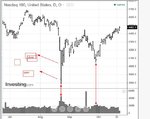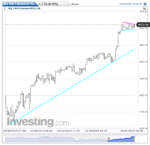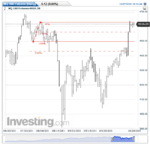You are using an out of date browser. It may not display this or other websites correctly.
You should upgrade or use an alternative browser.
You should upgrade or use an alternative browser.
- Status
- Not open for further replies.
barjon
Legendary member
- Messages
- 10,752
- Likes
- 1,863
Gap opening?
dink to the left = open, dink to the right = close
Attachments
dbphoenix
Guest Author
- Messages
- 6,954
- Likes
- 1,266
That's not a gap, tho perhaps I still don't understand what you're referring to. There was a 50pt gap at the open, but that was it.
But as regards W, it doesn't matter. The climactic drop and reversal is all that matters. That plus the test a week later.
But as regards W, it doesn't matter. The climactic drop and reversal is all that matters. That plus the test a week later.
barjon
Legendary member
- Messages
- 10,752
- Likes
- 1,863
That's not a gap, tho perhaps I still don't understand what you're referring to. There was a 50pt gap at the open, but that was it.
But as regards W, it doesn't matter. The climactic drop and reversal is all that matters. That plus the test a week later.
I showed the open and close of the 24 August bar. So far as I can see the previous bar close was 4200 and the open of the 24 August bar was around 3850 . I could be going daft, of course, the Meds are still leaving me dopey.
Agree it doesn't affect the climax discussion much.
dbphoenix
Guest Author
- Messages
- 6,954
- Likes
- 1,266
As regards the index, that's probably true, at least in terms of a "phantom" gap. But futures didn't gap that much.
One of the chief advantages of the Wyckoff approach for me is that the entry price doesn't really matter. If one understands and accepts the continuity of price and how to assess risk, then he can enter pretty much where he pleases. I can't get into this in "basic" SLA because the continuity of price is foreign to most traders and because both beginners and struggling traders focus almost exclusively on "rewards" with no idea how to assess and manage risk.
One of the chief advantages of the Wyckoff approach for me is that the entry price doesn't really matter. If one understands and accepts the continuity of price and how to assess risk, then he can enter pretty much where he pleases. I can't get into this in "basic" SLA because the continuity of price is foreign to most traders and because both beginners and struggling traders focus almost exclusively on "rewards" with no idea how to assess and manage risk.
Thanks for the charts, Db. I have a few questions on the first set, two posts up.
- Re the short entry... was the trigger "hitting the wall" of 4455 per AMT (as discussed earlier) or are you demonstrating how one enters using the SLA, ie, on a break of the daily demand line? Or was a combination of AMT and SLA used?
- Did the median of the April-July range play a role in the short entry? Did it create a "top zone" of R that needed to be cleared before taking the short?
- We're trading the daily here right? But the hourly is used to manage the short, then to reverse to long on the break of the supply line?
- Were you on the lookout for anything as price approached the weekly channel bottom? Price seems to have sailed through it uneventfully.
dbphoenix
Guest Author
- Messages
- 6,954
- Likes
- 1,266
Thanks for the charts, Db. I have a few questions on the first set, two posts up.
- Re the short entry... was the trigger "hitting the wall" of 4455 per AMT (as discussed earlier) or are you demonstrating how one enters using the SLA, ie, on a break of the daily demand line? Or was a combination of AMT and SLA used?
The trade is taken because of the reversal environment. The demand line isn't necessary.
- Did the median of the April-July range play a role in the short entry? Did it create a "top zone" of R that needed to be cleared before taking the short?
The range is especially important, which is a major reason why the reversal short was taken. Both weekly and daily traders were and are well aware of that 4-month range and of its importance. Their actions matter much more to moving price than those of daytraders.
- We're trading the daily here right? But the hourly is used to manage the short, then to reverse to long on the break of the supply line?
If one is trading the hourly, the cue is still taken from the daily, just as the cue for the daily is taken from the weekly. If one were to exit via the hourly, as shown, he could switch back to the daily and buy the BO from the top of the daily swing high. His choice. If he were trading from New York, it wouldn't make much difference. Russian and Asian traders would have the advantage here.
- Were you on the lookout for anything as price approached the weekly channel bottom? Price seems to have sailed through it uneventfully.
If you're referring to August, I was looking for climactic action. Price may have sailed through it, but that range reasserted itself after the test and has been affecting trading ever since. You may have noticed that the September swing low corresponds to the January swing low. Which may be coincidental. And irrelevant. No way of knowing until one observes how traders behave(d) as that level is(was) approached. Particularly those who trade daily and weekly charts.
I see, so the QQQ trades similarly to the NQ but involves dealing with nightly gaps. Risk/reward is minuscule if you trade one share, making it a good kiddie pool 😱 for someone like me hesitant to jump into the deep end of the NQ? Actually, a really good suggestion. Thanks.
dbphoenix
Guest Author
- Messages
- 6,954
- Likes
- 1,266
Many traders, particularly beginners, flock to forex and options because they appear to be "cheap". However, cheap is not necessarily inexpensive (see Yugo), not when the trader struggles for months or years and can never gain traction. A loss is a loss, and losses in superficially cheap instruments mount up like any other loss. And if one has essentially wasted a year or two or five, then his transition to profit becomes that much more difficult, assuming he doesn't just say the hell with it and quit.
The Q has a personality all its own, but many of its more unfortunate quirks can be ameliorated if it is used as a vehicle for trading the NQ.
Db
The Q has a personality all its own, but many of its more unfortunate quirks can be ameliorated if it is used as a vehicle for trading the NQ.
Db
Gring0
Well-known member
- Messages
- 264
- Likes
- 128
I have been seriously thinking about moving to NQ maybe some time next year. The risk control is unmatched due to 24 hour trading. Q's are wonderful and reduce risk due to less leverage in one way, yet, the gaps do increase the risk in other ways, neutralizing some of the benefits.
Overall NQ has this greater control that perhaps takes some time trading to appreciate. It is more powerful as one can set a stops even in the after hour market. Quite a bit of nicer entries have been occurring in the after hours more frequently. Options as Db was mentioning are fine but have huge commissions compared to futures and really have the added danger of being active during the times when the markets are open.
The good thing about me is that I am in no hurry and a progression that's natural is automatically taking place as I keep at it one the side. Very little pressure due to it not being a full time thing. I also am not hampered by intra-day trading and prefer a bit slower pace of daily to hourly intervals.
Gringo
Overall NQ has this greater control that perhaps takes some time trading to appreciate. It is more powerful as one can set a stops even in the after hour market. Quite a bit of nicer entries have been occurring in the after hours more frequently. Options as Db was mentioning are fine but have huge commissions compared to futures and really have the added danger of being active during the times when the markets are open.
The good thing about me is that I am in no hurry and a progression that's natural is automatically taking place as I keep at it one the side. Very little pressure due to it not being a full time thing. I also am not hampered by intra-day trading and prefer a bit slower pace of daily to hourly intervals.
Gringo
Attachments
High end of the range for me.Those who are trading hourly charts will have noted that we are dead on the mean of the hourly range. Therefore, there is nothing to do until price tests one or the other of the range limits.
Db
Attachments
dbphoenix
Guest Author
- Messages
- 6,954
- Likes
- 1,266
I have been seriously thinking about moving to NQ maybe some time next year. The risk control is unmatched due to 24 hour trading. Q's are wonderful and reduce risk due to less leverage in one way, yet, the gaps do increase the risk in other ways, neutralizing some of the benefits.
The gap issue is ameliorated somewhat by taking one's cue from the "mother", in this case, the NQ, just as one ought to be taking one's cue from the weekly to trade the daily and from the daily to trade the hourly and so on (the difficulties which people seem to have with trading the hourly, much less anything smaller, stem from forgetting about the context or ignoring it entirely).
Gring0
Well-known member
- Messages
- 264
- Likes
- 128
The gap issue is ameliorated somewhat by taking one's cue from the "mother", in this case, the NQ, just as one ought to be taking one's cue from the weekly to trade the daily and from the daily to trade the hourly and so on (the difficulties which people seem to have with trading the hourly, much less anything smaller, stem from forgetting about the context or ignoring it entirely).
Generally speaking gap isn't as big of an issue and not so recurrent. The thing that is pulling me towards NQ is the opportunity to exit positions without much trouble. Usually NQ doesn't have too many of those V reversals and using pure SLA one can just exit when reversal has taken place at night instead of letting profits evaporate until the open in New York. In any case there's no hurry. I cold just open a small account and play with it with one contract to get accustomed if I go that route.
Last edited:
Gring0
Well-known member
- Messages
- 264
- Likes
- 128
Db, when price rejects a point like 37.5, do you move down to the 1 min chart and wait for price to print below the bar that hit 37.5? Do you wait for price to come off of 37.5 a tick? At what point do you decide it's time to short?
If one has the time one can watch the 1min and make decisions off of it. If one doesn't have the time then a larger interval is naturally needed. Personally I use the hourly but if I am there and it's an important level then I zoom in to 5 min or 1 min for entry. (Note that the entry is still at the same level using daily/hourly not any breach of 5 min or 1 min D/S line at any randomly occurring place). If the level is being rejected it's visible on any bar interval. One sees price moving away. It could be either a dot in one bar travelling away or multiple new bars being formed by that same dot in smaller bar intervals for the same price movement.
Using larger interval usually gives a delayed entry. This later entry means the danger point is farther from the entry point, increasing the price risk. Entering on a smaller bar interval reduces price risk (due to entry being closer to the danger point) but increases information risk. It could turn out to be just a small move and go back to the original turning point. This is what a person has to figure out themselves whether they are comfortable with entering/exiting often or greater price risk with fewer entry/exits.
On a side note, this question is highlighting that you're not yet comfortable with seeing price as being continuous. It's not a bad thing, but is essential if one is to trade using this SLA-AMT way. I would suggest some screen time without the idea of finding entry/exit points and with say a 5 min and 1 min windows side by side. This is likely to eventually break through that subconscious fog of belief in the discreteness of price due to having different bar intervals.
Gringo
Last edited:
- Status
- Not open for further replies.




